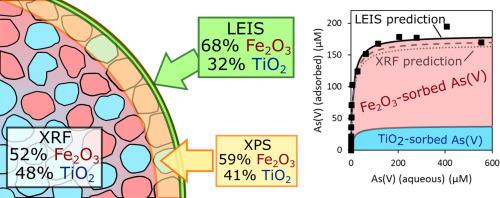Journal of Colloid and Interface Science ( IF 9.4 ) Pub Date : 2020-07-06 , DOI: 10.1016/j.jcis.2020.06.119 Jay C Bullen 1 , Janice P L Kenney 2 , Sarah Fearn 3 , Andreas Kafizas 4 , Stephen Skinner 3 , Dominik J Weiss 5

|
Novel composite materials are increasingly developed for water treatment applications with the aim of achieving multifunctional behaviour, e.g. combining adsorption with light-driven remediation. The application of surface complexation models (SCM) is important to understand how adsorption changes as a function of pH, ionic strength and the presence of competitor ions. Component additive (CA) models describe composite sorbents using a combination of single-phase reference materials. However, predictive adsorption modelling using the CA-SCM approach remains unreliable, due to challenges in the quantitative determination of surface composition. In this study, we test the hypothesis that characterisation of the outermost surface using low energy ion scattering (LEIS) improves CA-SCM accuracy. We consider the TiO2/Fe2O3 photocatalyst-sorbents that are increasingly investigated for arsenic remediation. Due to an iron oxide surface coating that was not captured by bulk analysis, LEIS significantly improves the accuracy of our component additive predictions for monolayer surface processes: adsorption of arsenic(V) and surface acidity. We also demonstrate non-component additivity in multilayer arsenic(III) adsorption, due to changes in surface morphology/porosity. Our results demonstrate how surface-sensitive analytical techniques will improve adsorption models for the next generation of composite sorbents.
中文翻译:

使用表面敏感的分析技术提高了多组分表面络合模型的准确性:砷在TiO2 / Fe2O3多功能吸附剂上的吸附。
越来越多的新型复合材料用于水处理应用,其目的是实现多功能性能,例如将吸附与光驱动修复相结合。表面络合模型(SCM)的应用对于了解吸附如何随pH,离子强度和竞争离子的存在而变化非常重要。组分添加剂(CA)模型描述了结合单相参考材料使用的复合吸附剂。但是,由于定量确定表面成分的挑战,使用CA-SCM方法进行的预测吸附建模仍然不可靠。在这项研究中,我们测试了使用低能离子散射(LEIS)表征最外表面可提高CA-SCM精度的假设。我们认为TiO 2/ Fe 2 O 3光催化剂吸附剂已被越来越多地研究用于砷的修复。由于未通过体积分析捕获氧化铁表面涂层,因此LEIS极大地提高了我们对单层表面工艺的组分添加剂预测的准确性:砷(V)的吸附和表面酸度。由于表面形态/孔隙率的变化,我们还证明了多层砷(III)吸附中的非组分可加性。我们的结果证明了表面敏感的分析技术将如何改善下一代复合吸附剂的吸附模型。











































 京公网安备 11010802027423号
京公网安备 11010802027423号